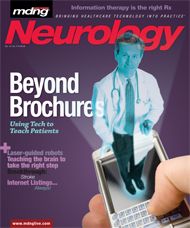Publication
Article
MDNG Neurology
Eye on Innovation: Calling All Doctors
Boris Rubinsky, professor of bioengineering and mechanical engineering at the University of California, Berkeley, explains his research using cell phone technology to reproduce medical imaging, which can then be transferred to a physician through his or her cell phone.
Boris Rubinsky, professor of bioengineering and mechanical engineering at the University of California, Berkeley, explains his research using cell phone technology to reproduce medical imaging, which can then be transferred to a physician through his or her cell phone.
Why use cell phones to transmit medical images? I’ve been working toward this goal for well over 10 years now and decided to focus on developing medical imaging for areas of the world with few resources. The particular application related to cell phones became obvious when I traveled to India, Th ailand, and China. People were speaking on their cellular phones and I realized that the phones were much more accessible than LAN lines, so I decided to look into something that was based on cellular phone technology, which led me to trying to fi gure what medical imaging technology would fi t developing countries. Understanding how medical imaging devices work, I began to think about the most essential and least expensive devices that need to be near the patient. Medical devices have three major components: they are made of a data acquisition device that adjusts the fi xed ideas on the ultrasound and the ultrasound transducers that you put on the body of the ultrasound probe. Then the information is transferred to the processor of a computer that processes the data that produces the image, which is the second component.
The image is transferred to a display, which is the third component. These three components exist in all devices, and of course one has to understand how to separately handle them and all of these spare parts for all three components. It occurred to me that the cellular phone can serve as a replacement and can facilitate this entire design. The data acquisition device has to be in the vicinity of the patient, but that’s the only thing that needs to be in the vicinity of the patient. Our idea was that the data acquisition device plugs into the cell phone (a) and transfers only the raw data, which can be turned into a simple text message (b). Then, using a powerful computer at a central location ©, the raw data is processed and the image is developed and sent back through the cellular phone (d) the same way that a photo taken with a camera phone is sent. This new arrangement allows a physician to visit a remote area or be in the field and bring his cellular phone wherever he goes. The main issue is maintenance and the low number of resources worldwide. What this has done is taken an expensive machine that is broken into three parts and distributed it to different geographic locations that are connected by cellular phone technology, leading to a simple and inexpensive imaging technique.
Will this concept work for all medical specialties? In terms of medical imaging, yes. The technology is very general and is used the same way as medical technology for every application. Th e most economical imaging applications would be electrical impedance tomography and ultrasound. Although it can be used with other technologies, the data acquisition part may be too expensive, but there is room to reduce costs. How successful has the testing been?
We have not tested humans yet, but the tests we’ve done have been successful as reported in the paper published in the April 30, 2008 issue of Public Library of Science ONE. We didn’t have to develop new technology. All we had to do was fi nd a way to use existing technology in a diff erent mode. Cellular phones exist, medical imaging exists, medical construction exists; we just rearranged the programs. We actually have a very interesting application in developed countries as well. We built a device that can be connected to the cellular phone that anyone in the United States could buy. It may be an interesting replacement for self examination. I think this technology will have a substantial aff ect on the cellular phone consumer market and on rural clinics. Underdeveloped countries aren’t the only ones that have these problems. How long before the transmission of medical images via cell phones is a standard medical tool?
I think these things are driven by necessity. Cellular phones have become an indispensable tool for everything. In my opinion, this concept will probably become something that is used very widely in a couple of years.






